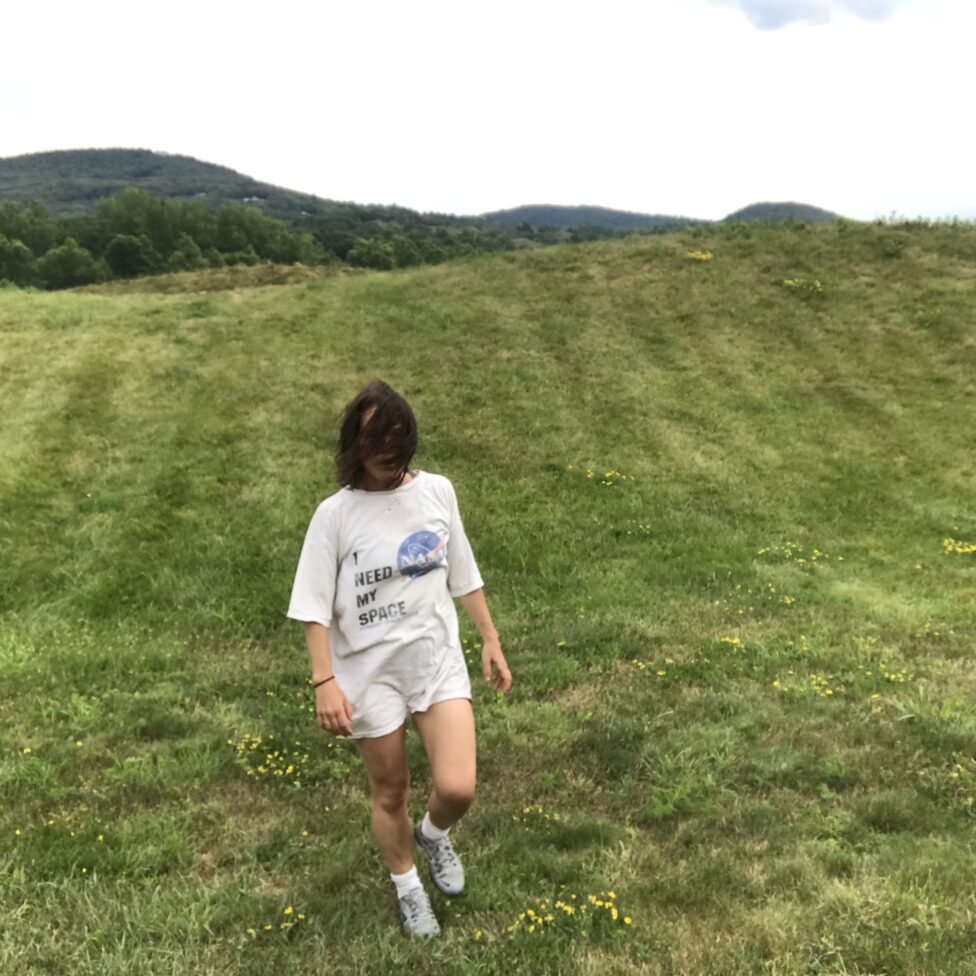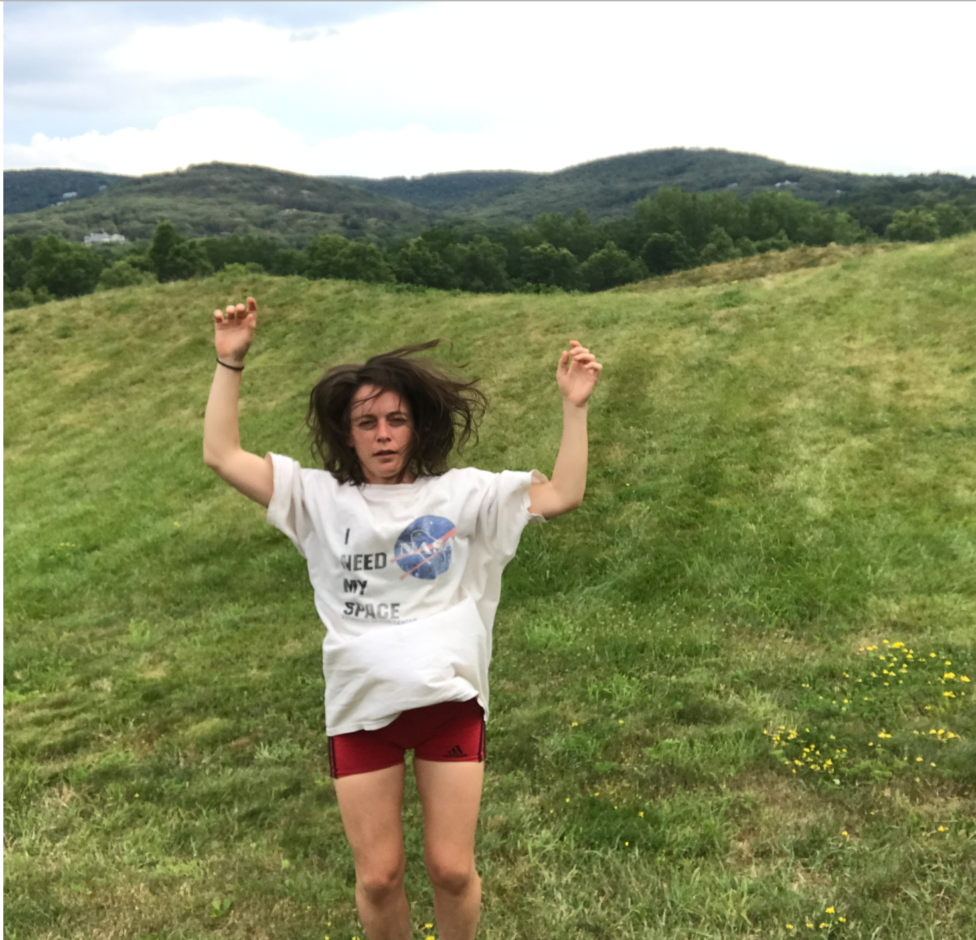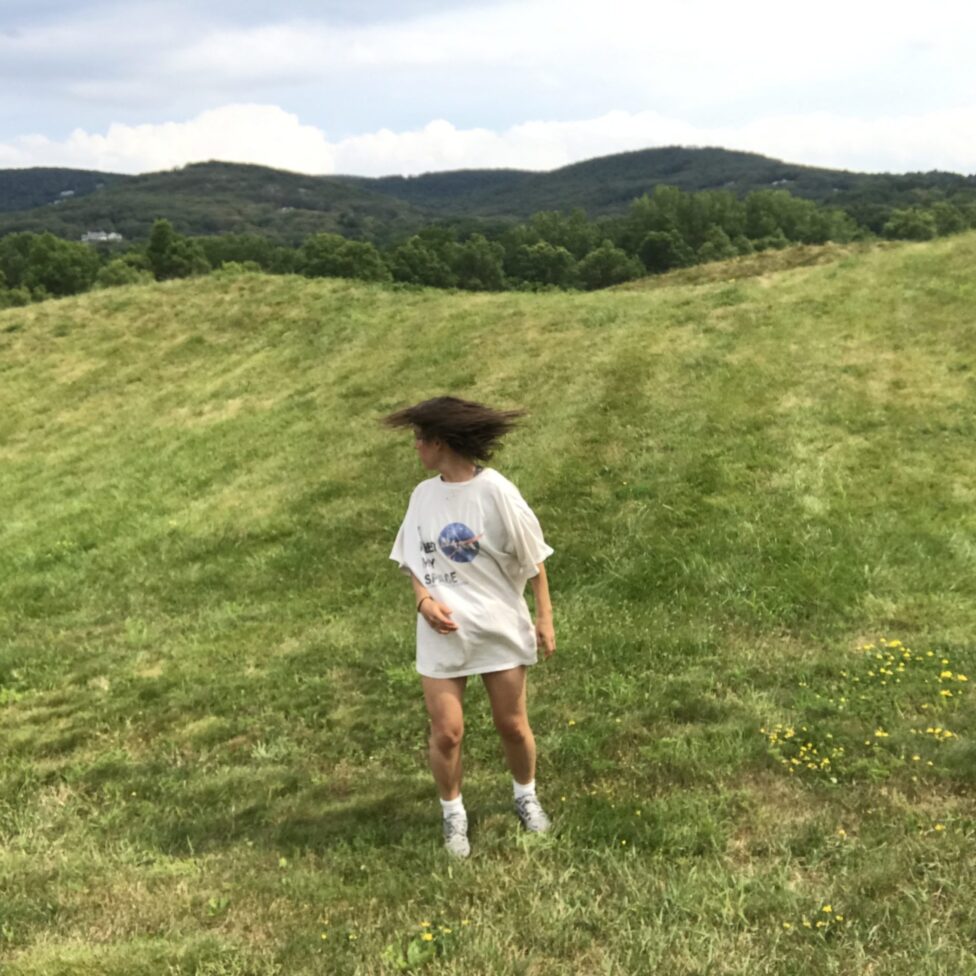Lydia 1: What do I do?
Lydia 2: I dance. I do dance.
L1: I practice the practice of dancing.
L2: Yes, I am a moving body and an activated mind inside of other people’s choreographies.
L1: I use my body inside of frames that other people originate and formulate.
L2: I am like a vampire, lurking at the door of another person’s idea just waiting to get asked in. I am the parasite that tricks the cat lady to get more cats.
L1: Once I get asked in, or once I attach myself to another person’s process, where am I located in making the work?
L2: I enter the process they’ve initiated in the studio they booked with the funding they’ve raised for the show they will name and be named by. My role is to open up a certain part of myself, make my appropriate capabilities available, and then continuously try to get better and better at whatever it is I am trying to do. Knowing I also may not get any “better” and being okay with that. I am trying. Trying to find how I will work inside of the work. I have to have a reason for being here. No one is forcing me to keep dancing. I’m the only one that needs it. No one is like “Lydia you must dedicate your life and body and any fiscal resources you may have to the pursuit of this thing that will never really ever give you anything back.” So I have to want to be in the process. I have to have a felt need to be in the process. I have to want to spend all those hours with all those people. The show is just a blip. A tiny point along the way. I have to like going into the studio and going into the world of the choreographer.
L1: I have to open myself to specific perimeters set up by the choreographer. But once I am there, once I’ve entered their world, my singular practice is activated. I am not void or vessel! I contain multitudes! There is something in what I do that isn’t found in training or a final product but, instead, in a quiet transference. I’ve started referring to it as embodied empathy power or, EEP. I am in constant collaboration- my EEP is activated by confronting someone else’s needs and vision, and then figuring out how to make it move and, perhaps, move you.
L2: At its best, the relationship between dancer and choreographer is a horizontal line of power. Once the frame is set up, we have to work together to bring the idea into being. It’s, hopefully, an incomprehensible hierarchy of power. Nothing is being written by a singular authority. Nothing can be.
L1: But I still acknowledge they are in charge, I still acknowledge that there are differences, large ones, to our roles. I still know we will feel different when the show approaches. There is, often, a special kind of anxiety that comes out before a show. I’ve noticed with almost every choreographer I’ve worked with. Part of my practice is knowing that that may happen and doing whatever I need to take care of myself or them. Or even better, just let it pass by. It’s just a passing phase, they get over it, we all get over it. So, yeah, I still have to give over a lot of trust to the choreographer.
L2: I don’t trust a lot of people, especially people in power. In an attempt to destroy tyranny, I typically misbehave or am irreverent. I let my fiery impulses do what they please as an intentional act of disobedience. But it is different with the choreographers I work with. They are not telling me how to be but, instead, asking me or inviting me to exist as myself (or a different self than I ever could have manifested on my own) within their frame. Damn it’s a special relationship.
L1: I like that my power to exist activates the work. I am compliant and disobedient all at once.
L2: My fiery impulses!
L1: I think for myself!
L2: Disobediently!

L1: But, I have to ask, why don’t I ever choreograph?
L2: It is simple. I do not want to.
L1: I am a power bottom. I make my work by dancing. That is my power and my work.
L2: When I tell people I am a dancer, their next question is “do you also make your own work?” There is an implied narrative of the dancer becoming choreographer.
L1: That is not the path I desire. I am invested in the agency of the dancer. I am dedicated to the work of practice and performance, all of that is all mine. Whether I’m dancing, writing about dancing, researching dancing or thinking about dancing, I’m making dance.
L2: But still, my legibility as an artist is activated by choreographers, and I am a participant in a medium that applauds the author.
L1: People don’t seem very comfortable with a person’s lack of drive to author something. They feel better watching you chase something down that you can attach your name to. A baby, a dance, a country.
L2: It is kind of colonialist, this preoccupation with the author and owner.
L1: I do author my experience. It is my responsibility to care for it, to feed it, water it, stretch it, put it to bed, show it a sight.
L2: A choreographer asks the body of the dancer to move but it is the dancer’s responsibility to move that body. How do I care for my body? What is my practice?
L1: This conversation is part of my practice. Stretching or not stretching is part of my practice. Going to rehearsal is part of my practice.
L2: An overarching theme of the dancers practice is having to overcome the fact that their body may not be able to…
L1: Is not able to…
L2: So I practice dealing with that conundrum.
L1: My practice is about practicing practice. Trying to perfect something makes me feel like an imposter. It sets up an idea that I should or have to be able to do something in order to exist in this role.
L2: Fake it till you make it
L1: Fake it till its made
L2: Just make it. Strive
L1: Pick yourself up and try again.
L2: Over and over again.
L1: Do I practice the dances on my own time?
L2: When I have a residency I do.
L1: Because then the studio is free?
L2: Of course. I don’t get many residencies though. There just aren’t that many residences that are interested in dancers. Most grants or residencies are geared towards artists who are the “Author” of the work. If I am ever rich and famous or just rich or just famous, I will start a grant for dancers.
L1: That is a good idea. Tricky to think how I would choose which dancers “deserved” the grant.
L2: I wouldn’t want it to participate in meritocracy. Perhaps it would be like the MR AIR program but for dancers and it would be money, studio time, and conversations. Maybe dancers would be nominated by choreographers?
L1: But then their “value” is dependent on the choreographers they have worked with. What if the lack of resources is exactly why they haven’t been able to work with many choreographers in the first place. There has to be another way that is only dependent on the work of the dancer. I guess it could be a lottery? Is an essay sufficient. I don’t know. I just don’t think it should be reliant on the choreographers.
L2: How do I feel about my bio being just a long list of other people’s names?
L1: I am not sure. It does make me feel that my value is based on who I have worked with. And if no one is asking me to be in their work…Then I would disappear entirely
L2: Which is why people put their name to something. To be understood, to exist, to not disappear.

L1: Adam already named everything. Reality has been captured. Signifiers abound. Once upon a time there was a formless and directionless chaos and then Adam came along and turned this primordial muck into thought and action. I’d rather be the serpent, the apple, Eve. The unnamed exists in dance. Dance is made of mutable facts, rendered true for instants at a time and then shattered. It disappears just as its made. A dog kicking up its tracks.
L2: Is my body a fact? Does it have value?
L1: I am here, literally and concretely. Factually. As a white woman I have a certain value and, in terms of the art world, this studio gives me value and the choreographers I work with give me value.
L2: Once I had a residency and they told me they don’t typically accept dancers because the dancer doesn’t have anything to give to the silent auction. There is no there there. What can I show residencies to help them understand what I do? That I do something, anything, at all? Residencies want to see the work their applicants have made. How can I show what parts are “mine”? Can you really tell where the choreography ends and the dancer begins? Or where the dancer ends and the choreography begins?
L1: I keep on saying that I am going to annotate a video from a performance I have been in, kind of like the sportscasters do for football games. I could draw lines and circles over the footage of the performance to show which parts were “mine.”
L2: But I still have managed to get some residencies through various arts organizations and, believe me, when I have access to a studio that is all mine, my work is a lot better. I am looking at an Ann Carson book right now, it is part of her collection Float. I haven’t read it yet but it is called Variations on the Right to Remain Silent. In the studio I take the right to remain silent and to silence the audience and the choreographer. I silence in order to understand my noise, my noise that is independent of others needs. Like a tree falling. One hand clapping. The silence before the storm. The silence before all is seen and told and heard.
L1: Why do I dance?
L2: I dance to disrupt order. I dance myself into relation, into sights of attention. All matter gets stirred up and repositioned. Through my synapses, steps, and breaths, I am conjuring new possibilities. Dance is a constant state of disappearing. Things no longer need to make sense. I dance to manipulate meaning, seeming, viewing, feeling, giving and taking. I dance to get something done. I dance because it is a completely irrational endeavor, because it doesn’t make sense in the world of capitalism, I dance because no one will ever make it as a dancer, I dance because you can only do it if you really fucking love it. I dance because I started at 5 and haven’t stopped. I dance because nobody else in my family does. I dance because I need to.
L1: Does the fact that it won’t really ever go anywhere scare me? There is no real trajectory for the dancer. No one else will know my value except for myself. I am not ever really gonna “make it.”
L2: I just want to be able to keep doing it. That is the part that scares me more. Stopping.





